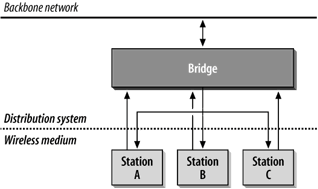The Distribution System, Revisited
With an understanding of how an extended service set is built, I'd like to return to the concept of the distribution system. 802.11 describes the distribution system in terms of the services it provides to wireless stations. While these services will be described in more detail later in this chapter, it is worth describing their operation at a high level. The distribution system provides mobility by connecting access points. When a frame is given to the distribution system, it is delivered to the right access point and relayed by that access point to the intended destination.
The distribution system is responsible for tracking where a station is physically located and delivering frames appropriately. When a frame is sent to a mobile station, the distribution system is charged with the task of delivering it to the access point serving the mobile station. As an example, consider the router in previous section "Extend Service Set". The router simply uses the MAC address of a mobile station as its destination. The distribution system of the ESS pictured in previous section "Extend Service Set" must deliver the frame to the right access point. Obviously, part of the delivery mechanism is the backbone Ethernet, but the backbone network cannot be the entire distribution system because it has no way of choosing between access points. In the language of 802.11, the backbone Ethernet is the distribution system medium, but it is not the entire distribution system.
To find the rest of the distribution system, we need to look to the access points themselves. Most access points currently on the market operate as bridges. They have at least one wireless network interface and at least one Ethernet network interface. The Ethernet side can be connected to an existing network, and the wireless side becomes an extension of that network. Relaying frames between the two network media is controlled by a bridging engine.
Figure below illustrates the relationship between the access point, the backbone network, and the distribution system. The access point has two interfaces connected by a bridging engine. Arrows indicate the potential paths to and from the bridging engine. Frames may be sent by the bridge to the wireless network; any frames sent by the bridge's wireless port are transmitted to all associated stations. Each associated station can transmit frames to the access point. Finally, the backbone port on the bridge can interact directly with the backbone network. The distribution system in Figure below is composed of the bridging engine plus the wired backbone network.

Every frame sent by a mobile station in an infrastructure network must use the distribution system. It is easy to understand why interaction with hosts on the backbone network must use the distribution system. After all, they are connected to the distribution system medium. Wireless stations in an infrastructure network depend on the distribution system to communicate with each other because they are not directly connected to each other. The only way for station A to send a frame to station B is by relaying the frame through the bridging engine in the access point. However, the bridge is a component of the distribution system. While what exactly makes up the distribution system may seem like a narrow technical concern, there are some features of the 802.11 MAC that are closely tied to its interaction with the distribution system.
In this tutorial:
- 802.11 Networks
- IEEE 802 Network Technology Family Tree
- Nomenclature and Design
- Types of Networks
- Independent networks
- Infrastructure networks
- Extended service areas
- Multi-BSS environments: "virtual APs"
- Robust security networks (RSNs)
- The Distribution System, Revisited
- Interaccess point communication as part of the distribution system
- Wireless bridges and the distribution system
- Network Boundaries
- 802.11 Network Operations
- Network Services
- Station services
- Distribution system services
- Confidentiality and access control
- Spectrum management services
- Mobility Support
- Designing Networks for Mobility
